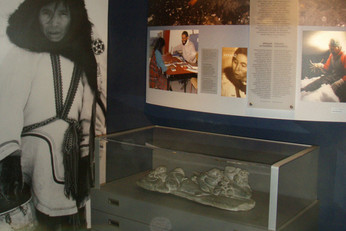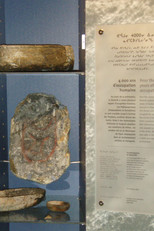Museology
Pingualuit National Park interpretation center
When Pingualuit National Park was created, the infrastructure included the construction of a visitors’ centre in the community of Kangiqsujuaq. Avataq Cultural Institute accepted the mandate to organize a permanent exhibit for the visitors’ centre, and made a long-term loan of a group of exceptional artifacts from the Inuit Art Collection of Nunavik, which Avataq manages.
Avataq also received from the renowned anthropologist, Professor Bernard Saladin d’Anglure, a significant donation of artifacts that he collected during his early years of research in the Kangiqsujuaq region during the early 1960s. Professor Saladin d’Anglure also assisted Avataq to reclaim, on behalf of the Kangiqsujuarmiut, a 24-foot long qajaq (kayak) that the anthropologist acquired during the same period. The kayak, which for some years had been displayed at the anthropology department at Université de Montréal, was built in the 1950s by Maasiu Ipuaraapik Ningiuruvik (1918-1985). An article in Makivik News (Winter 2004-2005) reported on the kayak’s historic return to its community of origin.
Permanent Exhibit – Pingualuit National Park
Pingualuit National Park in Kangiqsujuaq is the first national park in Nunavik, and since 2003, Avataq has been collaborating on its information programme by designing and mounting the permanent exhibit at the park’s interpretation centre. The permanent exhibit will be ready in the autumn of 2007. Avataq is carrying out this task at the request of the Nunavik Parks Section (Kativik Regional Government), under the supervision of the parks service of Quebec’s ministy of sustainable development, environment and parks (Ministère du Développement durable, de l’Environnement et des Parcs). The members of the Cultural Committee of Kangiqsujuaq provided ongoing contributions to this project.
The exhibit will allow visitors to explore the purpose, the breadth and the many riches of Pingualuit National Park. The first part of the exhibit focuses on the geomorphological transformations of the park area, and especially the role of the giant meteorite that produced Pinguluit Crater (formerly known as the Nouveau-Québec crater), about 1.3 million years ago. After learning about the ancient history of the region, visitors can then move on to learn about the territory’s 4,000 years of human occupation. The next portion of the exhibit deals with the area’s most recent occupants, the Inuit of Kangiqsujuaq. The exhibit contains some early clothing, as well as displays about significant events and remarkable people in the region’s history. Finally, visitors can follow a winding route to discover the rich wonders of the park through its five landscape units, culminating with the crater and its perfectly circular lake.
Many of the major pieces of this exhibit are taken from the Nunavik Inuit Art Collection – including the famous 7-metre qajaq (kayak) built by Maasiu Ipuaraapik Ningiuruvik (1918-1985), and a fragment of a petroglyph from the Qajartalik site. A number of impactites offer tangible evidence that the crater was indeed formed by a meteorite.


